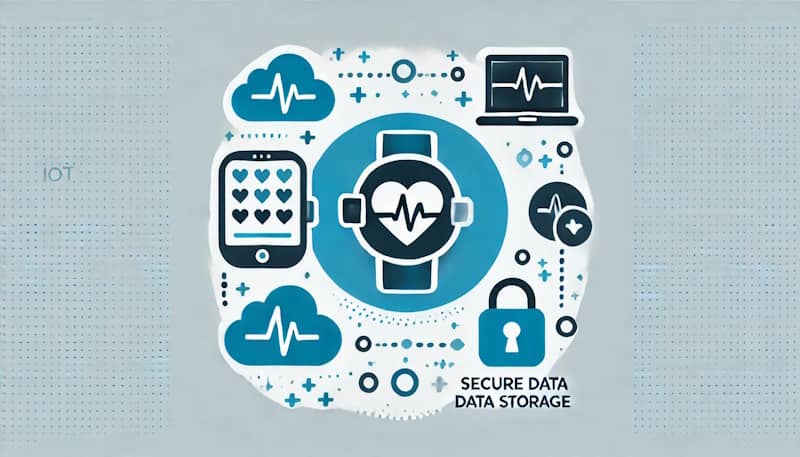The internet of things has greatly changed the way various industries function. The healthcare industry is one of the most affected. The services being provided to patients have been enhanced and can easily be managed as a result. When you start implementing IoT healthcare software development, it is essential to comprehend the important steps that need to be taken.
You can read through this informative overview of the key aspects and steps involved in IoT healthcare software development to understand everything you need to get started.
Key Components of IoT Healthcare Software Development
Different aspects of IoT healthcare software development cooperate to form the finished solution.
Sensors and IoT devices
Integration of various technologies is required since devices and sensors form the basis of the internet of things (IoT) in the healthcare sector. Health information like blood pressure, heart rate, and glucose levels is monitored by wearable devices, which offer real-time data. To assist in giving patients the best conditions possible, environmental sensors monitor variables like humidity and temperature in the surrounding space.
Data collection and management
IoT healthcare software development requires effective data management. This includes gathering data from numerous IoT devices and sensors, storing data securely using on-premises solutions or cloud-based solutions to handle large volumes, and integrating data seamlessly from disparate sources into a unified system.
Data processing and analysis
To transform unprocessed data into insights that can be used, robust processing skills are necessary. These include advanced analytics, where machine learning identifies patterns and predicts medical outcomes, and real-time processing, where data is evaluated as it is collected to provide warnings and insights instantly.
Communication and connectivity
For your IoT healthcare software development, dependable communication channels are crucial. To achieve this, you must integrate IoT communication protocols or cellular networks with strong connectivity.
User interface and experience
To make interfaces that are easy to use for both patients and healthcare providers, it is necessary to design mobile applications that are simple to use, create web-based dashboards for managing and visualizing data, and set up systems that quickly alert users to important health occurrences.
Privacy and security
To safeguard patient privacy, ensure that data is encrypted both during transmission and storage, implement strong permission and authentication controls for access control, and comply with healthcare laws such as HIPAA and GDPR.
Development Steps for IoT Healthcare Software
IoT healthcare software development involves some pivotal stages.
Analysis of requirements
Begin by obtaining and examining requirements from relevant parties such as patients, regulatory agencies, and healthcare providers. This will assist you in comprehending the particular requirements and limitations of your project.
System design
Designing the system architecture is a critical step that involves planning device interfaces, data flow, and communication protocols while ensuring the design accounts for scalability, reliability, and security.
Hardware and firmware development
Create or select suitable IoT devices and sensors for your project. Then write the necessary firmware to ensure device functionality and enable data transmission.
Software development
Create the backend systems needed for processing, storing, and gathering data. Make the front-end programs that will function as the UI. Use analytics software to convert data into insights that can be put to use.
Integration
Assure smooth connection with third-party services and current healthcare systems (EMR/EHR). This will improve data flow and interoperability across many platforms and devices.
Testing
Make sure your program operates as expected by putting it through rigorous testing. System, integration, and unit tests are all included in this. Also essential is user acceptance testing (UAT) with patients and healthcare providers.
Utilization
Install the program in a monitored setting. To guarantee optimum performance and dependability, keep a close eye on the system.
Upkeep and modifications
Continued upkeep and assistance are needed to resolve any problems that may occur. Update the program frequently to address issues, improve functionality, and guarantee ongoing security.
Overcoming Challenges in IoT Healthcare Software Development
While IoT healthcare software development brings numerous advantages, there are also some challenges.
Cooperation
It might be difficult to make sure that many systems and devices interact with one another properly. Use defined protocols and prioritize compatibility when designing.
Information security
It is essential to guard sensitive health data against breaches and illegal access. Put strong security safeguards in place and keep up with the most recent security best practices.
Adherence to regulations
Complying with strict healthcare laws might be difficult. Keep up with pertinent regulations and make sure your program meets all requirements.
Adoption by users
It can be challenging to persuade patients and healthcare professionals to embrace new technologies. Give thorough instruction and assistance to ensure a seamless adoption.
Future Trends in Healthcare That Depend on IoT
Several new trends indicate a promising future for IoT healthcare software development.
- Predictive analytics and individualized care will be improved by AI and machine learning.
- Blockchain technology will enhance the integrity and security of data.
- By processing data closer to the source, edge computing lowers latency.
- 5G connectivity facilitates more dependable and rapid data delivery.
Conclusion
When you understand these crucial elements and take the indicated actions, you can effectively negotiate the challenging IoT healthcare software development services market. Adopt cutting-edge strategies to meet the needs of patients and increase operational effectiveness as we advance healthcare.








